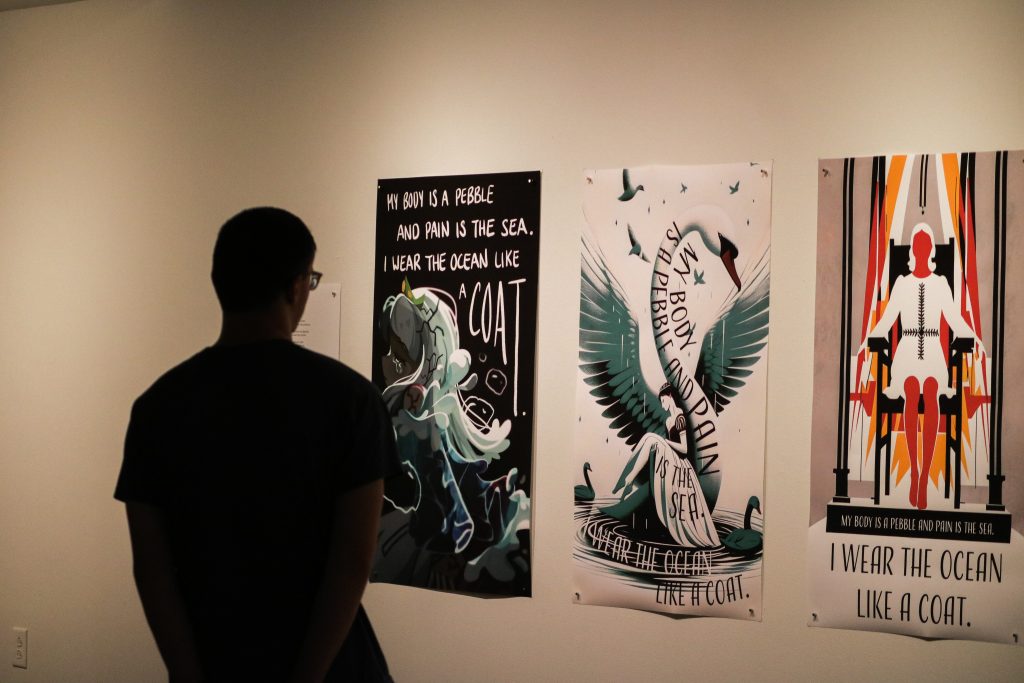As part of the trilogy of events titled Poetry and Art in the Post-Human Age, the departments of creative writing and art & design collaborated to display artistic fusion and creativity at Binghamton University’s Elsie B. Rosefsky Memorial Art Gallery, with renowned artist Sasha Stiles as the guest speaker.
Sasha Stiles is a Kalmyk-American poet, language artist and artificial intelligence (AI) researcher known for her generative literature and language art. Her artistic works explore what it means to be human in an evolving post-human era. She is the author of the “instant techno classic” poetry collection “Technelegy,” according to the Black Spring Press Group and has been named “the leading blockchain poet” by Right Click Save. In 2022, Stiles accomplished the significant achievement of being the first writer to publish literature created with the assistance of AI technology. This work was sold through a major auction house and earned Stiles several awards, including the Future Art Award, Optimism AI Award and Lumen Prize shortlist.
The exhibition took place on March 14 and opened with a welcome speech by Christopher Swift, assistant professor of art and design at BU, who led the collaboration for the student artists. Addressing the gathering of professors, event organizers, attendees, student writers and artists of BU, Swift shared how the event came to be and what its objectives were for the creative writing and art and design students.
“This exhibition is the conclusion of an almost year-long collaboration between the students of the creative writing department and the students of the department of art and design,” Swift said. “This project was about thinking and working through a collaborative process [with each other] and then complicating that by bringing in AI tools as well, as a collaborator. This led to a lot of conversation about the nature of collaboration and the role of our tools.”
Swift introduced Sasha Stiles to the audience and spoke of her artistic accomplishments, after which he acknowledged and congratulated all the student artists who displayed their artwork at Rosefsky Gallery. The exhibitions from each team consisted of three posters — a poem written by a creative writing student, an artistic poster designed by an art and design student and another poster which was the collaborative effort of both students as a result of partial AI generation.
Tina Chang, associate professor and director of creative writing, worked with Stiles to help shape the artist’s first book manuscript. Chang spoke of her vision for collaborating between the two creative departments on campus and the impact she hoped it would leave on the creative community.
“I hope the students will reflect upon the scope of [Stiles’] projects not only for the heavily considered and researched ways it delves into AI but, for her digital installations, her collaborative work with analog poets and artists, her creative innovations that consider literature, visual art [and] more,” Chang wrote in an email. “I hope that in the midst of debates about the impact and also dangers of AI, that [students] consider research from all perspectives, deepening their understanding of how, why and who might pose these projects and problems.”
The showcase introduced students to the transdisciplinary and multidisciplinary mediums of art and allowed them to experiment with different formats to gain a deeper understanding of the evolving discipline. Mercia Kandukira, a senior majoring in English, explained her exhibition and the process of how it evolved.
“Our work is called cognitive dissonance and features two posters and a short prose poem,” Kandukira wrote in an email. “The first poster is a fiery lake and the second is an image of a girl with her eyes crossed out with the word ‘impressionable.’ It took about four months. Our first meeting was in October, and the final posters were ready by March 1. I personally loved seeing the different drafts and interpretations [my partner] Kyra [a senior majoring in art and design] drew from the different pieces of writing we worked with.”
Stiles, who studied language and literature at Harvard University, spoke of how AI and art could work together without threatening an artist’s creative sense and originality.
“I think of AI as being an augmented imagination, helping me do more of what I like to do [and access] ideas, texts and minds that I otherwise wouldn’t come in contact with,” Stiles said. “[These] thematic threads running through [my work] make me really passionate and excited about working with AI.”
Stiles stated that the negative aspects of AI are very real too, and could take over certain areas of writing. However, Stiles sees this as an opportunity to explore new modes of literature humans could write about, citing that language and literature are always evolving and are never static.
When asked about her advice for emerging writers and artists exploring new tools to incorporate into their work, Stiles urged new artists to be interdisciplinary and explore various mediums as much as possible.
“There are so many opportunities to go beyond the conventional parameters of what we think of when we think of creative writing, [such as fiction, poetry, etc.],” Stiles said. “Technology has been a really great way [to push] against some of those boundaries, and getting to be experimental … and realize it’s really up to you to define the kind of work that you’re doing and not to feel like you have to follow prescripted guidelines.”



